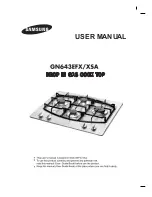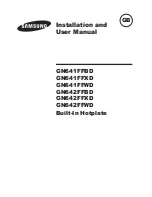
Tested for you in our cooking studio
en
29
Meat
Baste lean meat with fat as required or cover it with
strips of bacon.
When roasting, add a little liquid if the meat is lean. A
covering of approx.
^
cm depth should be applied to
the base of any glass cookware.
Score the rind crosswise. If you turn the joint when
cooking, ensure that the rind is underneath at first.
When the joint is ready, turn off the oven and allow it to
rest for another 10 minutes in the cooking
compartment. This allows the meat juices to be better
distributed. Wrap the joint in aluminium foil if necessary.
The recommended resting time is not included in the
cooking time indicated.
It is more convenient to roast and braise meat in
cookware. You can take the joint out of the cooking
compartment more easily in the cookware, and prepare
the sauce in the cookware itself.
The quantity of liquid is dependent on the type of meat,
the cookware material and also on whether or not a lid
is used. If preparing meat in an enamelled or dark metal
roasting dish, it will need a little more liquid than if
cooked in glass cookware.
The steam evaporates in the cookware when roasting.
Carefully pour in more liquid if required.
The distance between the meat and the lid should be at
least 3 cm. The meat may rise.
If necessary, braise the meat first by searing it. Add
water, wine, vinegar or a similar liquid to the braising
liquid. A covering approx. 1-2 cm deep should be
applied to the base of the cookware.
Fish
Fish cooked whole does not have to be turned. Place
the whole fish into the cooking compartment in
swimming position with the dorsal fin facing upwards.
Placing half a potato or a small oven-proof container in
the stomach cavity of the fish will provide stability.
You can tell when the fish is cooked because the dorsal
fin can be removed easily.
When stewing, add two to three tablespoons of liquid
and a little lemon juice or vinegar into the cookware.
Poultry
Meat
Dish
Accessories/cookware
Shelf position Heating
function
Temperature in
°C
Cooking time
in mins
Chicken, 1.3 kg
Wire rack
2
4
200-220
60-70
Small chicken portions, 250 g each
Wire rack
3
4
220-230
30-35
Chicken goujons, nuggets, frozen
Universal pan
3
%
190-210
20-25
Duck, 2 kg
Wire rack
2
4
190-210
100-110
Duck breast, medium, 300 g each
Wire rack
3
4
240-260
30-40
Goose, 3 kg
Wire rack
2
4
170-190
120-140
Goose legs, 350 g each
Wire rack
3
4
220-240
40-50
Small turkey, 2.5 kg
Wire rack
2
4
180-200
80-100
Turkey breast, boned, 1 kg
Cookware, covered
2
%
240-260
80-100
Turkey thigh, bone in, 1 kg
Wire rack
2
4
180-200
90-100
Dish
Accessories/cook-
ware
Shelf posi-
tion
Heating
function
Step
Temperature in
°C
Cooking
time in
min
Fillet of beef, medium, 1 kg
Cookware, uncovered 3
%
-
210-220
45-55
Pot-roasted beef, 1.5 kg
Cookware, uncovered 2
%
-
200-220
100-120
Sirloin, medium, 1.5 kg
Cookware, uncovered 2
4
-
200-220
60-70
Burger, 3-4 cm thick
Wire rack
4
(
-
3
25-30**
Joint of veal, 1.5 kg
Cookware, uncovered 2
%
-
180-200
120-140
Knuckle of veal, 1.5 kg
Cookware, uncovered 2
%
-
210-230
130-150
Leg of lamb, boned, medium, 1.5 kg
Cookware, uncovered 2
4
-
170-190
70-80*
Saddle of lamb on the bone, medium, 1.5 kg
Wire rack
2
4
-
180-190
45-55*/**
* Do not turn
** Insert the universal pan at level 1.








































